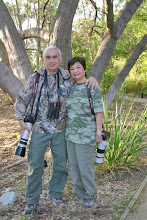We kept hearing the "cu-cu-cu" coming from behind the trees. We looked at where that sound was supposedly coming from but didn't see anything. After a while it came out and for a couple of minutes dried itself in the sun. The Philippine Coucal was our first bird that morning along the road going to Infanta.
From there we stopped by the places where the hagimit trees were. The fruit of this tree is a favorite food of several species of birds. Unfortunately, summer had come and the fruits were all gone at the areas we visited. Except for one place. We saw friends Conrad and Ralf inside a compound as we were driving by. We quickly joined them and they introduced us to Francis, the overseer of that place. Close to their lawn was a huge hagimit tree with lots of fruits still. While we were catching up with our friends, Francis pointed at the tree, "Buzzing Flowerpeckers," he said. Indeed a pair of that species came and started feeding on the red berries.
There was a lull after the flowerpeckers left. Then, "Philippine Pygmy Woodpecker!" Francis once again pointed to the fruiting tree.
This routine had become the norm of that morning. Francis, who was lounging on a hammock, would get up when he hears some bird call, look for the source of that call, and assist us to see the bird that would appear in the area. Two more species were shown to us: the Elegant Tit..
and the colorful Olive-backed Flowerpecker.
Around 9 am Cynthia and I decided to go visit the area where the Paddyfield Pipits are sure sightings. We promised to be back by 10:30 as that was the usual time that the Philippine Hanging Parrot was supposed to come to the fruiting tree.
Unfortunately, there were some "tourists" at the Pipit domain. We did see the bird but it was a bit skittish, unlike before, and I never got a good photo of it. On the other hand, farther down the road, a Striated Grassbird posed for us.
By 10:30 we were back at Francis' place. But the Parakeet never showed up. Only the Buzzing and Olive-backed Flowerpecker returned. Conrad told us that about 3 minutes after we left, a Stripe-headed Rhabdornis came, followed later by a Flaming Sunbird. Ah, if only we had stayed and benefited some more from Francis' assistance at seeing the birds in his neighborhood.
Hen Harrier at Long Last!
3 days ago












